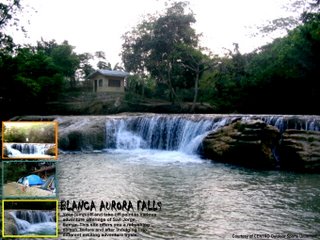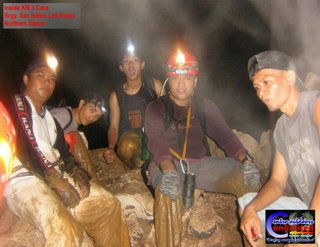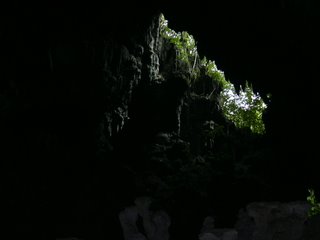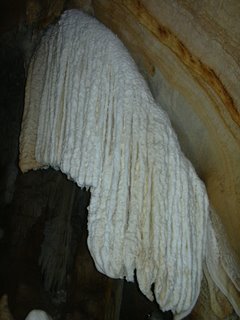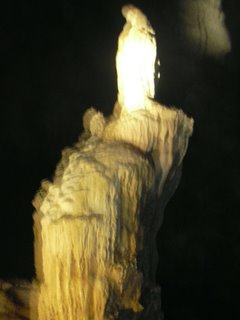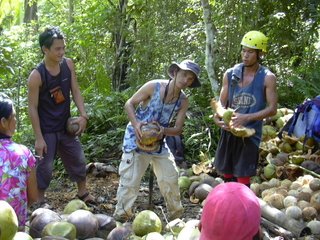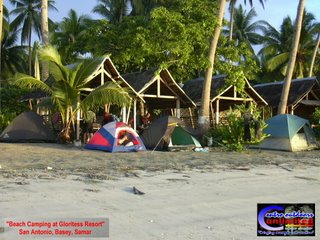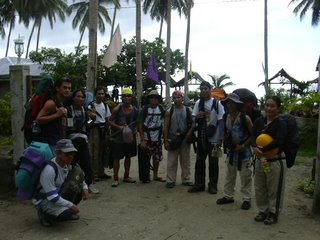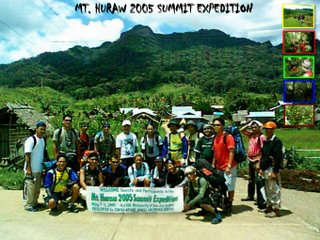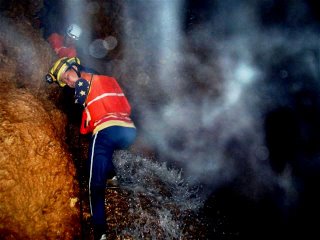
IN PHOTO: One of our 'comrade' Ms. Goldie doing a dangerous descend on the cascading waterfall in one of the Negros Caves.
___________
Inspired by the possibilities of economic benefits of the Tourism Industry – but marks a fact of being a neophyte in the industry -, the Municipality of Guihulngan has invited a selection of outdoor enthusiasts to help the town explore and assess its potentials relative to Adventure Tourism.
A 10-man group was formed by CENTRO OUTDOOR SPORTS UNLIMITED, a Samar-based event-organizer, to answer the exploration call.
The Negros-bound group was hopeful that they would be able to explore a sizeable number of natural caverns that can be recommended to be turned into “natural” tourist attractions, and be complimented with man-made developments for the purpose of conveniency and safety to visitors – cavers and non-cavers alike.
The exploration which is on a mini-inventory format – was granted by the Samar Selection Team – is FREE of service charges, with the exploration team even has to shell out funds from their respective group/individual coffers for their fare from their respective places of origins to the Municipality of Guihulngan, Negros Oriental, and back.
In exchange, the HOST (LGU-Guihulngan) provideD our food and exploration supplies, including the on-site transportation and accommodation expenses that will be incurred by the exploration team during the entire duration of the activity.
HERE ARE OUR CAVE ASSESSMENT & INVENTORY RESULT:
1.SAYAW CAVE = is an underground water system with no traces of eye catching cave formations, it is a muddy horizontal cave and not ideal for cave tourism, but the cave can be used for caving sports (Sports Tourism) but the unpredictable rise of river flow inside should be taken into consideration to avoid any fatal incidents.
Appropriate trail to the Sayaw cave is the TINITIAN CAVE TRAIL, and not the other way around, the Tinitian cave trail is more proximate to the suggested Mag-aso Cave Campsite.
2.TINITIAN CAVE = is an elevated horizontal dry cave, and is ideal for cave tourism, but the LGU should take into consideration the depleting status of this cave – prospected visitors of this cave should be well-briefed of the “no’s” inside the cave to preserve the remaining white rock formations inside.
3.MAG-ASO CAVE 1 = is a wet cave, with more or less 50 meters vertical entry. This cave is the most beautiful cave the exploration team has visited in Guihulngan, to mention the fact that a cave exit is offered to possible guests.
It likewise offers an excellent camping area, proximate to a running potable water supply inside the cave or within the area of the Mag-Aso Cave 2, its proximity to the main road make the potential of this cave enormous relative to the tourism industry of the town.
However, the Mag-Aso Cave 1 is a hydrology cave, and therefore must be offered only to guests who are not new to caving, guests who insist of entering and exploring this cave should have the right caving aptitude and attitude.
No life jackets, no local guides (TRAINED) to assist a guest – NO ENTRY, make this policy mandatory for the Mag-Aso Cave 1.
Vertical Entrance of the cave should be cleaned-up, fence should be built around it to avoid accidents. If funds is available foundations for rope trysts can be installed to make it more convenient to guests, you can tap the help of the engineering office to lay-out the appropriate development of the area, to include possible resting areas made of indigenous materials..
Other man-made attraction can spice up the caving tourism activity in the area, such as horseback riding or trekking – this will solely depend to private individuals who maybe interested in sharing their resources and at the same time earning with it…
Mag-Aso cave 1 can be the carriers of other tour packages that can be offerred and promoted by the municipality of Guihulngan, it is a feasible site for any caving or adventure events, this will however depend on the kind of promotions and marketing that can be developed by the tourism office of the municipality.
4.MAG-ASO CAVE 2 and 2-A = Just a short walk from the Marg-Aso Cave 1, is another twin-cave system, with a sloping entrance. The same with the cave 1, this cave is a wet cave, but not as forceful as the cave 1 – it is a host to large or cathedral type chambers with mountains of rock debris to climb.
Its potential is for side-trip caving adventure, especially the tunnel type
chambers that runs deeper with the water flow. Its entrance however should be cleared-up with debris and litters, and safe trail down the slopes should be established to avoid slipping.
5.CAN-TAYSON CAVE = One of the most promising natural caverns in the town of Guihulngan, again – courtesy of an exit. The cave is not as big as the other caves found within the perimeter, but this one offers a mini-extreme caving tryst that will surely test a cavers aptitude on the sports. Its narrow and wet passages are one of a kind that makes it unique from the rest.
A more visible trail to the entrance should however be established, and if ladders is needed to ensure the safety of the guest, at the cave entrance, – it must be installed as well.
Neophyte cavers can enter the cave provided a trained guide should accompany them.
6.LAOS CAVE = is a muddy cave and is suitable only for extreme caving, and must be offered not to neophyte cavers due to the danger of lose rocks by the entrance which is of vertical type – though rock climbing skills can be used.
Based on the geological formations found inside, the cave has the tendency to be flooded on the 1st chamber during rainy days, which was confirmed by the local residents in the area, thus, extreme caution relative to the weather conditions should be observed before entering this cave.
7.KINAYAN CAVE = is the most appropriate cave for all type of guests, and can be developed even for student field trips, etc. This is possible because of its proximity to the main hi-way and to the Kinayan Waterfalls which is ideal for washing-up after a caving adventure.
The cave however is extremely damage, with a lot of paints graffiti inside; though, the cave is not yet dead, but preventing further damage to it must be put into consideration.
We recommend for the closure of this cave from anybody – most especially to the locals within the area – for it to regenerate its beauty and grandeur. You can seek the recommendation of the DENR people on how to clean-up the mess inside.
In totality, the activity was successful – averaging to at least 2 caves per day – is not bad despite the unavoidable circumstances that occurred during the preparations and the start of the exploration.
For future explorations, the Special Rescue Team should be in standby status and should not go along with the exploration team, to save their energy just in case untoward incidents occurred; or they can join as participant of the exploration same with the rest of the team for personal experience or training.
In choosing a base camp, the presence of water must be taken in for consideration, either for drinking, wash-up or for cooking. Likewise, a base camp should be proximate enough to the majority of the priority routes of the exploration.
For tour guiding events, support staff should be limited according to their compacted functions – this will minimize expenses and sped-up mobilization, a local guide for example can act as the porter as well, while the LGU or Professional Tour Guides can help in the food preparation with the guests. In most cases, the local guide would act as the navigator inside the cave, or whoever who has the extensive knowledge of the area inside the cave, while the LGU or Professional Tour Guide can act as the sweeper, to see to it that nobody of his or her guests are left behind.
PROMOTIONS
Since Guihulngan’s Tourism pursuit is at its infancy stage against the unavailability of substantial funds from the LGU coffers, investments on marketing and promotions should be well planned and executed with utmost precision, and must directed towards a productive market or target.
TV Plugs or Prints Advertisements can be powerful in terms of promotions but they are the most costly form of promotional projects, with no specific or assurance of absolute returns, hence the following suggested promotional strategies:
1.Event Organizing = using a cost-sharing scheme, you can start promoting your tourism sites to the local based outdoor groups, by inviting them to join your various planned activities. This will enable your Tourism Office to establish a network who can help and assist you in the disseminating information regarding the potentials of the town’s various tourism sites.
Once ready for a bigger event, you can go Nationwide using the earlier network you have established with the local groups, still focusing on the same category of participants – Outdoor Adventurers – since they are the most sought after individuals for queries here and abroad, and most likely, they could easily impart information and experience, if they themselves got a grasp of the adventure you have offered.
2.Race/Competition Organizing = though quite complicated for starters, considering the manpower required, this promotional strategy is as effective as the other events. Though this, a lingering desire in the participants to be back with their group, peers, friends, contacts etc. usually lingers – this time not to compete, but to enjoy the adventure sites that they have gone through.
This was imminent to the International Elf Endurance Competition held in Samar last 1999, where foreign participants of the competition, keeps on coming back, not to compete but this time to enjoy the adventure route they once competed for a prize, of course, with their outdoor comrades this time; the strategy can reap a multiplier effect.
3.Internet Posting = the most needed medium of promotion that you should maintain, 100% of adventure tourists rely on information that is being offered on the net. In most cases, LGUs at this era maintains a website as mandated by the Local Government Code, but this websites become useless due to lack of interest to continuously update its contents. The tourism Office can re-format such websites, giving focus on the tourism potentials of the LGUs, and establish linkages to various travel and tour facilitators on the net, or any established tourism websites.
4.Ready-Made Tour Packages = Tour Packages are important, and must be available anytime. There are thousands of tourism destinations in the country, giving prospected tourists a variety of choices where to spent their money, letting them wait due to the absence of Tour Packages, will mean loosing your chance to have them in your place, and without you knowing it, your tourism industry will just die its natural death.
These ready made tour packages can be posted on the net, or printed on leaflets and distributed to Travel Agencies – or at any other outlets with connections to tourism, travel etc.
Tour packages must be rated minimally, for it to become competitive in the tourism market.
5. Participation on Travel or Tourism Fairs = One avenue that the government has initiated is the WOW PHILIPPINES, though this is limited to Provincial representation, LGUs can participate by sending in support representatives to the province booth who can articulately discuss with booth visitors, all aspect of the town’s tourism offerings – and personally distribute fliers or brochures containing tour packages. Other travel fair is Travel Mart – where you can establish direct negotiation and contact to various travel agencies, thus giving you access to their international network.
6. Organizing Local/Campus based-Outdoor Groups = basically, this strategy will give the LGU a chance to impart its destinations locally – and make use of these grottos as a machinery either for tourism manpower or for promotions. It is a fact that students are the most active elements in the society, aside from being idealistic to some extent, and making use of these character will help boost the LGU tourism campaign.
Once again, in behalf of the Samar Expedition Team – I would like to extend our deepest and heartfelt gratitude to the most warmest hospitality you – Guihulnganons – have shared with us.
 The CENTRO OUTDOOR SPORTS UNLIMITED
The CENTRO OUTDOOR SPORTS UNLIMITED 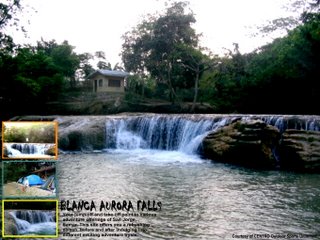


 By Martin Sluka
By Martin Sluka